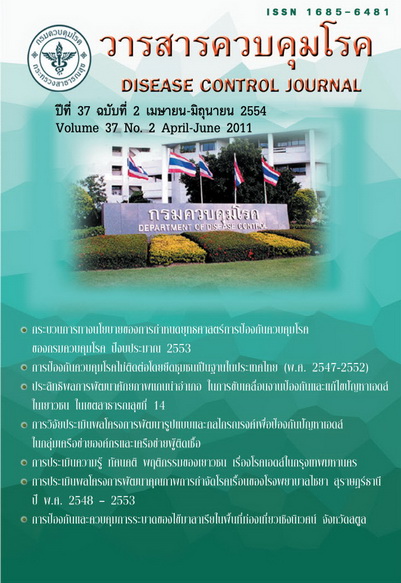Process of Strategic Policy on Disease Prevention and Control of the Department of Diseases Control, 2010
Keywords:
Strategy for disease prevention and control, Department of Disease ControlAbstract
This participatory qualitative research was conducted to analyze the strategic policy and the process of strategies policies for diseases prevention and control. The contents of study were collected and presented in 4 perspectives such as financial, customer, internal process and learning & growth in part of strategic policy and in the part of process of strategic policy was detailed on strategic formulation, evaluation & monitoring and transfer to practice. The 56 samples were the administrators and health technical officers worked in the Department of Disease Control in fiscal year 2010. The results revealed that the strategic policy in 4 perspectives were clear and effective. The financial perspective, the fiscal budgets management was set clearly at the beginning of the fiscal year. The customer perspective, the health care networks in district level were emphasized. While internal process perspective, the organization structure and management were adjusted suitably between administration and academic works, including human resource development. The learning and growth perspective, the expert groups were established to provide suggestions to the CEO and develop organization to be an expert organization for prevention and control diseases. The monitoring was performed by the CEO directly and through internal communication routes such as teleconference including, follow up the involved documents monthly, three monthly and yearly. For the transferring policy to practice, the process of transfer to descending organizations were assigned with making a clarify and understandable issues for health officers who practice in the field. This study suggested that strategic policies of prevention and control diseases in the long run should be adjusted by surrounded situations. The CEO should be the leader of change and a new wave generation was urgently developed.
Downloads
References
2. ศูนย์อำนวยการบริหารยุทธศาสตร์เมืองไทยแข็งแรง (ศอม.). การสร้างและใช้แผนที่ยุทธศาสตร์สำหรับองค์กรระดับปฏิบัติการ. นนทบุรี: สำนักงานหลักประกันสุขภาพแห่งชาติและสำนักงานกองทุนสนับสนุนการสร้างสุขภาพ, มปท.
3. วิพุธ พูลเจริญ, สุรพล เหลี่ยมสูงเนิน, สมบัติ เหสกุล, เยาวลักษณ์ เงินวิวัฒน์กุล, ราม รังสินธุ์, เดชวัต สุขกำเนิด และ วีรสิทธิ์ สิทธิไตรย์. แผนที่ยุทธศาสตร์กรมควบคุมโรคปี 2550: เอกสารสรุปผลโครงการพัฒนาตัวชี้วัดและประเมินผลแผนกลยุทธ์การเฝ้าระวังป้องกันควบคุมโรคและภัยสุขภาพ. นนทบุรี: กรมควบคุมโรค กระทรวงสาธารณสุข, 2550.
4. ธีระชัย เชมนะสิริ. เรื่องน่าคิด ชีวิตคนทำงาน. พิมพ์ครั้งที่ 3. กรุงเทพฯ: สถาบันเพิ่มผลผลิตแห่งชาติ, 2552.
5. เบญจา ยอดดำเนิน-แอ็ตติกจ์, บุปผา ศิริรัศมี และวาทินี บุญชะลักษี. การศึกษาเชิงคุณภาพ: เทคนิคการวิจัยภาคสนาม. พิมพ์ครั้งที่ 4. นครปฐม: สถาบันวิจัยประชากรและสังคม มหาวิทยาลัยมหิดล, 2541.
6. อคิน รพีพัฒน์, ชยันต์ วรรธนะภูติ, อมรา พงศาพิชญ์, สุภางค์ จันทวานิช และฉวีวรรณ ประจวบเหมาะ. คู่มือการวิจัยเชิงคุณภาพเพื่องานพัฒนา. พิมพ์ครั้งที่ 2. สถาบันวิจัยและพัฒนา มหาวิทยาลัยขอนแก่น . กรุงเทพฯ: ด่านสุทธา, 2537.
7. สำนักงานคณะกรรมการข้าราชการพลเรือน. คู่มือการพัฒนาระบบการบริหารมุ่งผลสัมฤทธิ์. พิมพ์ครั้งที่ 9. สวัสดิการสำนักงาน ก.พ. ดุสิต กรุงเทพฯ: พี.เอ.ลีฟวิ่ง, 2547.
8. สุรชาติ ณ หนองคาย. การวางแผนและการจัดการเชิงกลยุทธ์. เอกสารประกอบการประชุม "กระบวนทัศน์ใหม่ในการบริหารเชิงกลยุทธ์" ระหว่างวันที่ 16-18 กันยายน 2545 ณ โรงแรมรอยัล ริเวอร์. กรุงเทพฯ: สถาบันราชภัฏธนบุรี และสำนักงานสภาสถาบันราชภัฏ, 2545.
9. มานิต รัตนสุวรรณ. เคล็ดลับนักบริหาร. กรุงเทพฯ: มณีทัศน์, 2537.
10. สุนทร เกิดแก้ว. การบริหารโครงการ: การติดตามควบคุมและการประเมินผล. กรุงเทพฯ: คณะรัฐประศาสนศาสตร์ สถาบันบัณฑิตพัฒนาบริหารศาสตร์. จุฬาลงกรณ์ราชวิทยาลัย, 2537.
11. ณรงค์วิทย์ แสนทอง. คู่มือการพัฒนาระบบบริหารผลงานยุคใหม่.กรุงเทพฯ: เอช อาร์ เซ็นเตอร์, 2545.
12. ทิพย์วัลย์ สีจันทร์, เยาวเรศ ทองนอก, ทิตยา เทพมงคล, ปารินดา สุขสบาย, อุบล ชื่นสำราญ, ทิฐิมา นวลบุญ, พัชรีพรรณ เสวะมาตย์, จารินี ศานติจรรยาพร, กัลยาภรณ์ จันตรี และวรพจน์ หริตกุล. การคิดและการตัดสินใจ . พิมพ์ครั้งที่ 6. กรุงเทพฯ: มหาวิทยาลัยราชภัฎสวนดุสิต , 2549.
13. รุ่ง แก้วแดง. รีเอ็นจิเนียริ่งระบบราชการไทย ภาค 2. พิมพ์ครั้งที่ 2. กรุงเทพฯ: มติชน, 2540.
14. Jeffrey J. F. เขียน ภัทราพร ฟูสกุล แปล. How to become CEO วิถีสู่ผู้นำองค์กร. กรุงเทพฯ: ซีเอ็ด ยูเคชั่น, 2547.
15. สุรชาติ ณ หนองคาย. จิตวิทยาการทำงานและภาวะผู้นำ : ทฤษฎีสู่การปฏิบัติ. เอกสารประกอบการเรียนการสอนหัวข้อ "การบริหารวิทยากรกระบวนการ และการพัฒนาบุคคลให้เป็นวิทยากรกระบวนการ" แก่ปลัดเทศบาลและปลัดองค์การบริหารส่วนตำบล. กรมการปกครอง กระทรวงมหาดไทย และสำนักงานบริการเทคโนโลยีสาธารณสุขและสิ่งแวดล้อม (OPHETS): คณะสาธารณสุขศาสตร์ มหาวิทยาลัยมหิดล, 2545.
16. ปราณี กองทิพย์ และมังกร ปุมกิ่ง. หลักการจัดการ.กรุงเทพฯ:พัฒนาวิชาการ(2535), 2546.
17. Gary D. เขียน ชำนาญ ปิยวนิชพงษ์, เกื้อจิตร ชีระกาญจน์, จันทวรรณ เปรมประภา, มณีรัตน์ จันทรเนตร และชลิดา กาญจนจูทะ แปล. กรอบแนวคิดสำหรับการจัดการทรัพยากรมนุษย์. กรุงเทพฯ: เพียร์สัน เอ็ดดูเคชั่น อินโดไชน่า, 2549.
18. วีรวุธ มาฆะศิรานนท์. การบริหารภูมิปัญญา. กรุงเทพฯ: เอ็กซเปอร์เน็ท, 2542.
19. Rachel K. M. and Bruce C. The power to change, Bangkok: Grid Driving Culture change, Grid teamwork Ltd.
20. Robert B. เขียน ยุดา รักไทย และวีรวุธ มาฆะศิรานนท์ แปล. Performance Management การบริหารผลการปฏิบัติงาน. กรุงเทพฯ: เอ็กซเปอร์เน็ตบุ๊คส์, 2545.
21. Sumantra G., Heike B., William O. K., Jr. Donald L. W. เขียน พิพัฒน์ นนทนาธรณ์ และวีรวุธ มาฆะศิรานนท์ แปลและเรียบเรียง. Habits of Highly Effective Managers อุปนิสัยผู้จัดการประสิทธิผลสูง.กรุงเทพฯ: เอ็กซเปอร์เน็ท, 2548.
22. วิชัย โถสุวรรณจินดา. หัวหน้างานยุคใหม่. กรุงเทพฯ: ธรรมนิติ, 2536.
23. สุพานี สฤษฎ์วานิช. การบริหารเชิงกลยุทธ์ แนวคิดและทฤษฎี. พิมพ์ครั้งที่ 2. กรุงเทพฯ: คณะพาณิชยศาสตร์และการบัญชี มหาวิทยาลัยธรรมศาสตร์. ซีเอ็ดยูเคชั่น, 2546.
24. บุญศักดิ์ แสงระวี. หูจิ่นเทา ผู้นำจีนคนใหม่. กรุงเทพฯ: สุขภาพใจ, 2546.
25. ธงชัย สินติวงษ์. การวางแผนเชิงกลยุทธ์. กรุงเทพฯ: ไทยวัฒนาพานิช, 2532.
Downloads
Published
How to Cite
Issue
Section
License
Articles published in the Disease Control Journal are considered as academic work, research or analysis of the personal opinion of the authors, not the opinion of the Thailand Department of Disease Control or editorial team. The authors must be responsible for their articles.






